How to Read the Lead Sheet for a Bass
In order to read accordion bass notes on a score, you need to know the bass clef. The squeeze box bass note is quite simple, If you already know how to read the treble clef it will be much easier to learn how to read the bass clef.
In case you don't know the treble clef all the same, take a look at this lesson "How to read music notation" which will teach y'all how to read the treble clef.

(Photo by OB OA on Unsplash)
How to read the bass clef
Knowing the treble clef, you can use some simple tricks to read the bass clef:
- read notes every bit if they were written in the treble clef and so add ii notes, so for example if in the treble clef you have an E on the start line, in the bass clef yous will have to read information technology as a G; an A in the treble clef is a C in the bass clef; a B in the treble clef is a D in the bass clef and so on.

Or instead of calculation notes,
- you can but read the bass clef notes equally if they were positioned ane pace higher, so if yous see a note on the get-go line, imagine it is positioned on the second line and read it as y'all would if you were reading the treble clef. Same matter for a note placed in a space on the staff: for example, you come across a note on the 2d space, well, that note is the equivalent of a note placed on the third infinite of a treble clef staff.

There are three kinds of bass notes on the accordion:
- Bass
- Counter-bass
- Chords
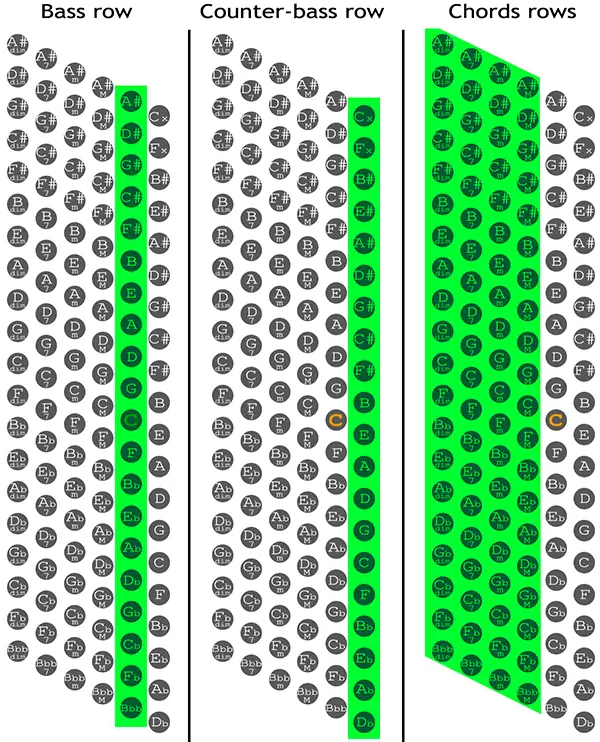
Bass notes are on the 2nd row.
Counter-bass notes are on the 1st row.
Chords are on the 3rd, 4th, fifth, and 6th row.
Position on the staff
Bass and counter-bass are in a lower position on the staff than squeeze box bass-chords. On piano accordion scores, usually, in the lower position, you'll detect a D and in the highest, a C.
Take a expect at the staff below.
Bass & Counter bass: 
Chords: 
Accordion bass notation
The standard accordion bass note is quite elementary as basses, counter basses, and chords are all represented with a unmarried note on the staff. Since there are 4 different kinds of chords on the squeeze box (major, minor, seventh, and diminished), you volition find a letter, a number, or an abridgement about a chord-note: it defines the nature of the chord ("M" for major, "m" for minor, "7" for dominant 7th and "dim" for diminished chords).
The lower notation is a bass and the higher note is a chord. As you can see in the example beneath, the notation for major, minor, 7th, and diminished chords is always the same: there're two C notes, an octave apart. The lower is a C bass and the higher is a C chord.
C Major:
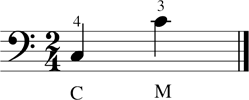
C minor:
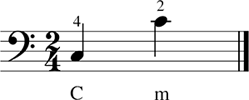
C Dominant seventh:

C Diminished:
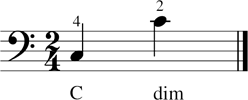
(Fingering for major chords is 4-iii, for minor, 7th and macerated is four-2 )
The Stradella bass system
The Stradella bass system was designed to play traditional and pop classical pieces, waltzes, mazurkas, polkas, marches, etc. The most common rhythmic patterns are in four/4, in iii/four, and in 2/4 (which it can be written in 4/4 as well). There're many other common time signatures but allow's focus just on 4/iv (marches, ballads, pull a fast one on-trot, and polkas for instance) and 3/4 (waltzes, mazurkas, minuets, and dances).
Here you can meet the same melody written for squeeze box, for pianoforte, and for any other instruments ("Just chords").
A simple melody in 4/four:

and the same melody in 3/four:
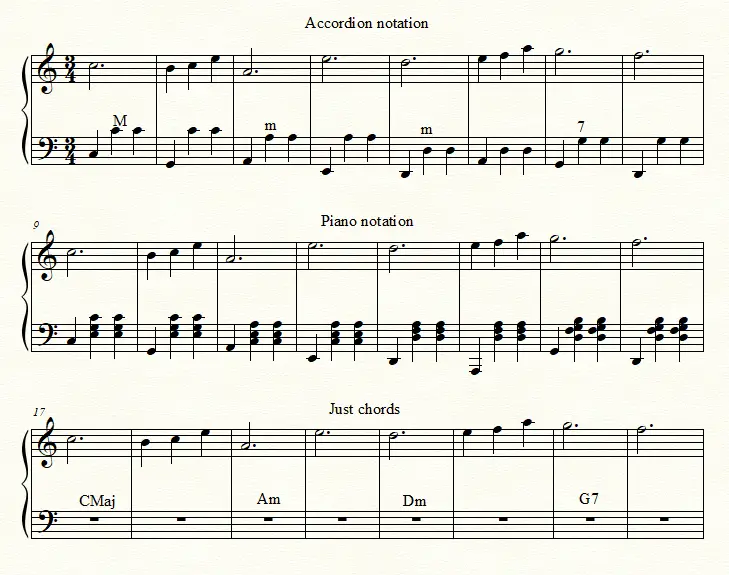
In this example, there are four chords: C Maj, A min, D min, and Grand 7th.
Regardless of the fourth dimension signature, you can see how bass notes follow the same pattern:
(C – 1000), (A – E), (D – A), (G – D)
These are all fifth intervals and in fact, accordion basses are bundled in a circumvolve of fifths. This ways that y'all can alternate roots and 5ths very hands on the piano accordion and therefore it is very easy to play all those rhythmic patterns in which there is this alternation of bass.
Accordion notation for the left mitt is very simple since all chords are written as one single note. On a piano, you can choose to play unlike inversions of the same chord or you tin can play a bass note at a lower octave but on the squeeze box, there's just 1 octave for basses, and chords can't exist changed, you can't play chords inversions on a standard bass accordion. This is why accordion annotation is so less detailed than pianoforte annotation.
Once you lot know how to conform a rhythmic blueprint, all you lot need in guild to play an accompaniment for a melody is to know the chord progression. Jazz and popular music, for instance, are commonly written on a single staff with chords symbols and so, in my opinion, it's important to learn how to play as many different styles of accompaniments every bit possible because sometimes the score doesn't requite yous any information near information technology.
Piano accordion counter bass notation
Accordion counter bass notes are often underlined with a footling dash so you tin can distinguish them from bass notes.

Squeeze box bass chords combination
A combined accordion bass chord is a chord that combines a root note (bass or counter bass) and a bass chord (major, small, 7th, or diminished) from a different root line. For example, D minor seventh (Dm7) combine a D bass note and an F major chord, permit'south explain why:
Small seventh chords are modest chords with a dominant 7th. On squeeze box, there're "minor" and "7th" chords but no single button for "minor 7th" chords. To play a modest 7th chord on accordion you demand to play the root and the other three notes which complete it.
- D minor (Dm) is a triad consisting of the pitches D (root), F (pocket-size third), and A (fifth).
- D small-scale seventh (Dm7) is a quadriad consisting of the pitches D (root), F (small 3rd), A (fifth), and C (minor seventh).
Probably your first thought is to add a C to the D minor chord but this is not the solution since if you add a bass C annotation, it sounds as if C were the root of the chord created (something like C, D, F, A).
The right solution is to apply D as root, then adding the notes that complete the Dm7 chord: D + F, A, C. Which chord plays these notes all together? The answer is: F major chord.
And so, to play a Dm7 on piano accordion bass you need to push button the D on the bass or on the counter bass row and the F major.
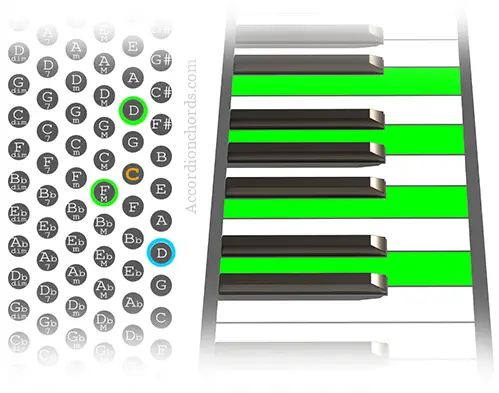
Combined bass chords note
Note for combined accordion bass chords follow the same rules explained before:
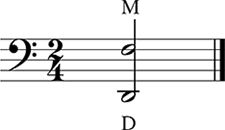
Accordion notation for Dm7 (D minor 7th)
The lower note is a D, this means that D is the root and the higher note (F) is a chord. The letter "M" indicates that the F chord is major. Although this is a right fashion of representing the Dm7 chord, yous are more than likely to find the chord name, as combined chords are used in musical genres that usually don't use double staff.

From "All of me" (G. Marks and S. Simons)
For this reason, it's important to larn chords as patterns in club to play circuitous chords on accordion bass.
Squeeze box scales
Since the starting time two bass rows are single notes, it'south possible to play scales with the left hand. In the example beneath you can see the D major scale:

There're many scales with different fingering merely I'll talk near other kinds of scales in some other post. As you can see, bass and counter bass notes are combined in a specific sequence with a specific fingering. The dashes and fingering numbers help to find which push button you need to play in sequence.
Writer: Giovanni Lucifero
Source: https://accordionchords.com/tutorials/how-to-read-accordion-bass-notes/
0 Response to "How to Read the Lead Sheet for a Bass"
Post a Comment